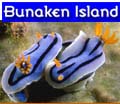
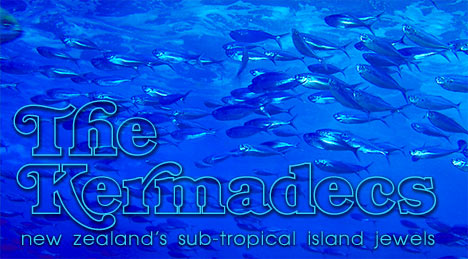
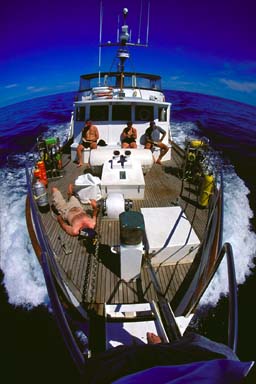 |
New
Zealand has a number of remote island territories from the subantarctic
islands of the ferocious Southern Ocean to the Chatham Islands to
the east but it is the Kermadec Islands, far to the north east, that
probably hold the most appeal for the adventurous New Zealand diver.
Lying approximately 1000 km from the New Zealand mainland, the Kermadec
Islands comprise a group of volcanic rocks and islets separated by
almost 250 km. Rising out of one of the deepest of ocean trenches,
they seem out of place, tiny specks of land in a huge, endless ocean.
Because
of their remoteness, these subtropical island jewels are seldom visited
but with their remote location brings a promise to fascinate all who
make the effort to visit them.
For many years a trip to the Kermadecs had been a dream of mine. It
is seldom that there is an opportunity to join an expedition there
so when I heard of a trip planned for early in 2001, I was determined
not to miss out. So it was that a group of eight divers began to assemble
in Tauranga one afternoon early in March for what promised to be the
trip of a lifetime diving expedition.
After loading a small mountain of equipment and supplies onto the boat we waited impatiently for final preparations to be completed. Our home for the next 11 days was to be M.V. Atu, a 21 metre, 50 tonne charter launch equipped with every amenity necessary to ensure our safety and comfort.
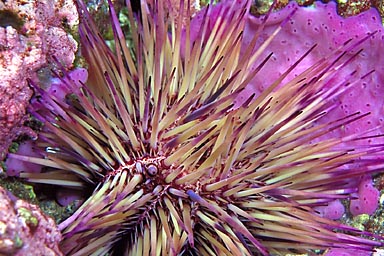 |
We departed Tauranga at 5.20 that evening and once outside the harbour, set a course for L'Esperance Rock, some 454 nautical miles (840 km) distant to the north east. The weather during the last few days had not been good but by the time we departed, there was scarcely any wind and only an easterly swell remained to downgrade conditions from ideal.
After a somewhat restless sleep we awoke on our first morning at sea to find conditions little different from the previous evening. Only the swell caused the boat to roll uncomfortably as we inched our way towards the distant Kermadecs. With nothing to do other than relax and wait for hundreds of miles of sea to pass beneath us we gobbled down our breakfast and eased into a life of laziness.
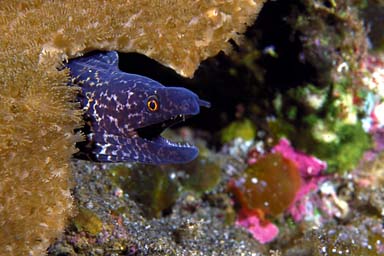 |
Even
at this early stage of our voyage the sea had turned that lovely deep
blue colour indicative of excellent underwater visibility and we found
ourselves impatient to get into some diving.
By mid afternoon on our first day the lack of wind had caused the
sea surface to become almost glassy. In these conditions it was possible
to stand on the bow of the boat and get a good view of life below
the surface. For long periods there was little to see except a few
jellyfish and salps but occasionally, a few small fish or squid would
dart along in front of the bow wave with the squid sometimes propelling
themselves out of the water. Slightly more exciting were several flying
fish which launched themselves into flights lasting 10 seconds or
more and a couple of sunfish with big dorsal fins flopping lazily
above the surface.
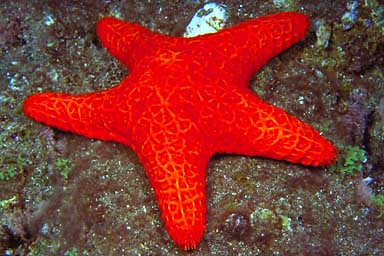 |
The
first day had passed rather quietly until late in the afternoon when
a shout "marlin!" came from the stern. We'd been trolling
lures for most of the day but had pretty much lost interest in them.
After the shout went up we raced to the back of the boat from where
we watched the marlin leap acrobatically from the water several times.
After a tug of war lasting almost an hour our lucky first time marlin
fisherman, Ian, had subdued the beautiful fish sufficiently to pull
him alongside the boat from where we wasted little time in releasing
him. So ended the first day of our voyage to the Kermadces.
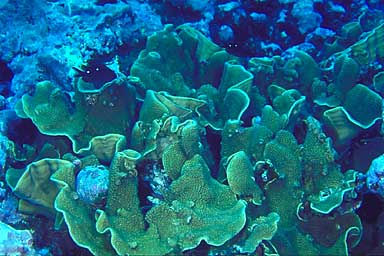 |
The morning of our second day at sea greeted us with continuing fine weather. The easterly swell persisted and the nonexistent wind of the previous day was now blowing at about 10 knots but we felt rather fortunate to have had such a comfortable trip thus far. Better still, the weather faxes we were receiving indicated that we could expect the good weather to continue for at least a few more days.
During
the morning our lazy trolling efforts were rewarded with a small mahi
mahi which pounced on a lure and put up little resistance in coming
to the boat. Later in the morning we gained a day as we crossed the
international date line and passed into the eastern hemisphere.
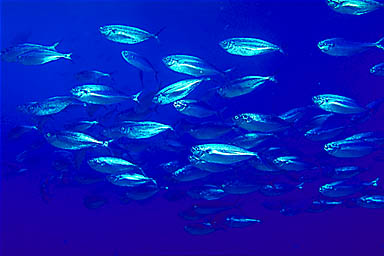 |
An
ocean voyage in a small boat gives you a good appreciation of the
massive extent of the ocean on this planet of ours. Spending so much
of our lives on land makes it very easy to forget this but after days
of voyaging across a huge featureless expanse of blue, the ocean inevitably
takes on a much greater significance.
By the morning of the third day, we were all becoming impatient and
keen to know when we'd be able to get our first dive in. It seemed
likely that we would make the southern most island, L'Esperance Rock
at about 9 pm that evening. Being too late to do a dive, we decided
to continue to motor through the night so that we would be at Curtis
and Cheeseman Islands first thing the following morning.
Before going to bed that night we watched the radar anxiously for
the first indication of L'Esperance Rock. This was a rather interesting
time as our navigation had been totally dependent on the boat's electronic
global positioning system (GPS) and it is only when this rock, less
than 300 metres across, appears in the middle of nowhere that we could
be sure we were in the right place. The radar showed nothing for a
long time and most of us had gone to bed when it finally began to
appear on the radar about 12 miles distant and just where the GPS
said it should be.
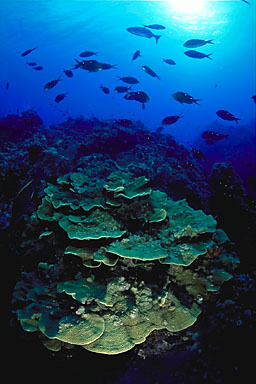 |
We had tucked ourselves in behind the western side of Cheeseman Island to get some shelter from the easterly winds now blowing at about 15 knots. We waited for a an hour or so to let the morning sun poke its head up from behind the island before slipping into our dive gear and taking the plunge into an underwater world that none of us had experienced before.
The water kissed our faces and revealed a very blue world in visibility of about 30 metres (100 ft). As we dropped to the bottom at about 35 metres we gazed about us at the odd mixture of fish, some of them very familiar but others quite unexpected in New Zealand waters. Gold-ribbon grouper, rarely seen in New Zealand were abundant and often shared a crack with toadstool grouper or yellow banded perch. Kingfish and kahawai cruised about much as they would at home but the larger fish out in the blue, the sharks, definitely didn't fit a typical New Zealand underwater scene. A pair of these sharks came in to inspect us more closely and must have been a little confused by the strange intruders in their domain. As always they are beautiful creatures and inspire nothing but exhilaration (until they start doing that back arching thing and drop their pectoral fins).
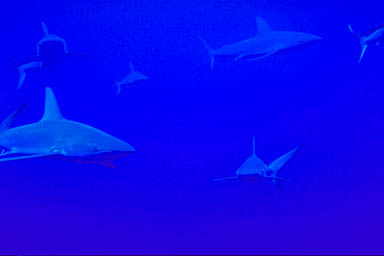 |
For
the second dive at the day we stayed anchored at Cheeseman Island
before moving on to the nearby Stawell Shoal for our third dive. Here
we were treated to one of those great underwater experiences that
remain memorable amongst hundreds of dives. From the moment we submerged
our faces below the water until the moment we climbed back on board
the boat the sharks were with us.
We
had anchored on what seemed to be the shallowest part of the reef
where a number of jagged pinnacles rose to within five metres of the
surface. A ring of these pinnacles seemed to form a natural amphitheatre
where fish of all varieties congregated. Schools of large kingfish
cruised through schools of drummer, kahawai and demoiselles. Beautiful
yellow banded perch occupied many of the cracks in the rocks where
we also saw several lionfish. All the while, the sharks glided amongst
the other fish but generally kept their distance from us.
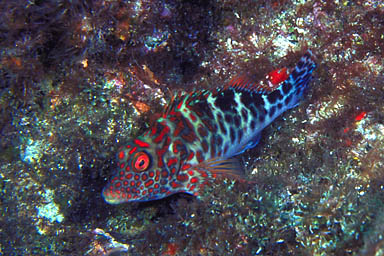 |
As
the end of the dive approached, other divers began to make their way
back to the anchor chain. Eager not to miss any of the action I stayed
down as long as I could and when I finally started to make my way
towards the anchor, most of the other divers had either left the water
or were doing a safety stop close to the boat.
As I moved towards the boat, the nearby sharks followed me. Soon,
the other divers had left the water and I was on my own with a larger
group of sharks coming ever closer. This did become a slightly uncomfortable
situation but they seemed more inquisitive than aggressive and it
definitely makes for a much more pleasant dive if you marvel at what
beautiful animals they are rather than dwell on their potential to
shred you.
At the end of the day we all headed for bed fairly early feeling very
satisfied with our first day's diving at the Kermadecs. We would motor
through that night past the next island to the north, Macauley Island,
and continue north towards the largest and only inhabited island of
the group, Raoul Island.
Continue
on to The Kermadecs - Part 2
© 2001 ianskipworth.com
